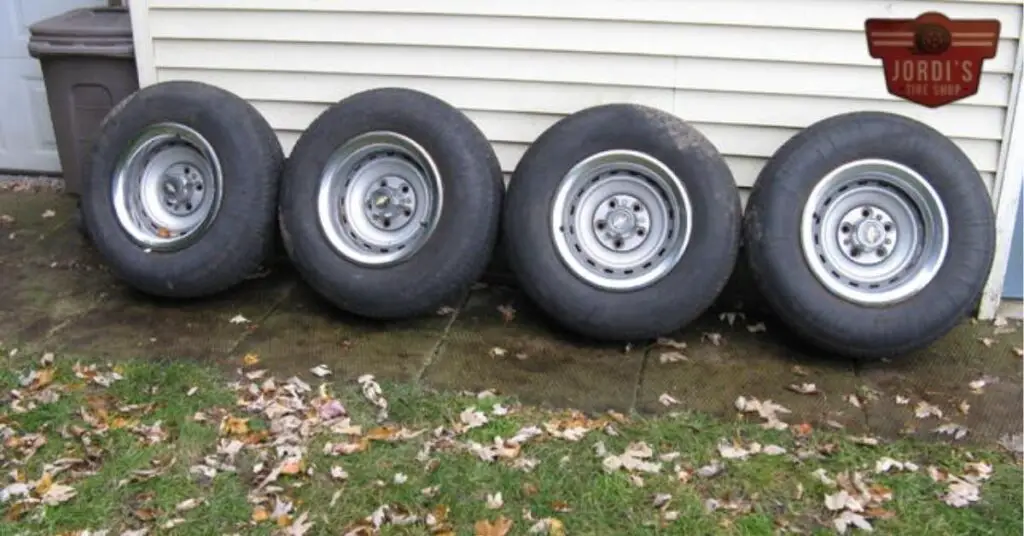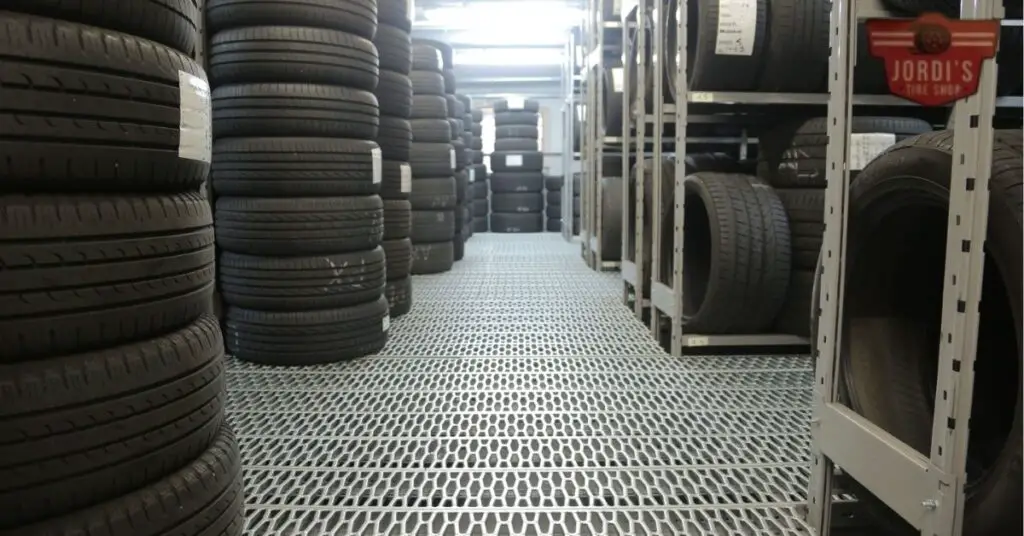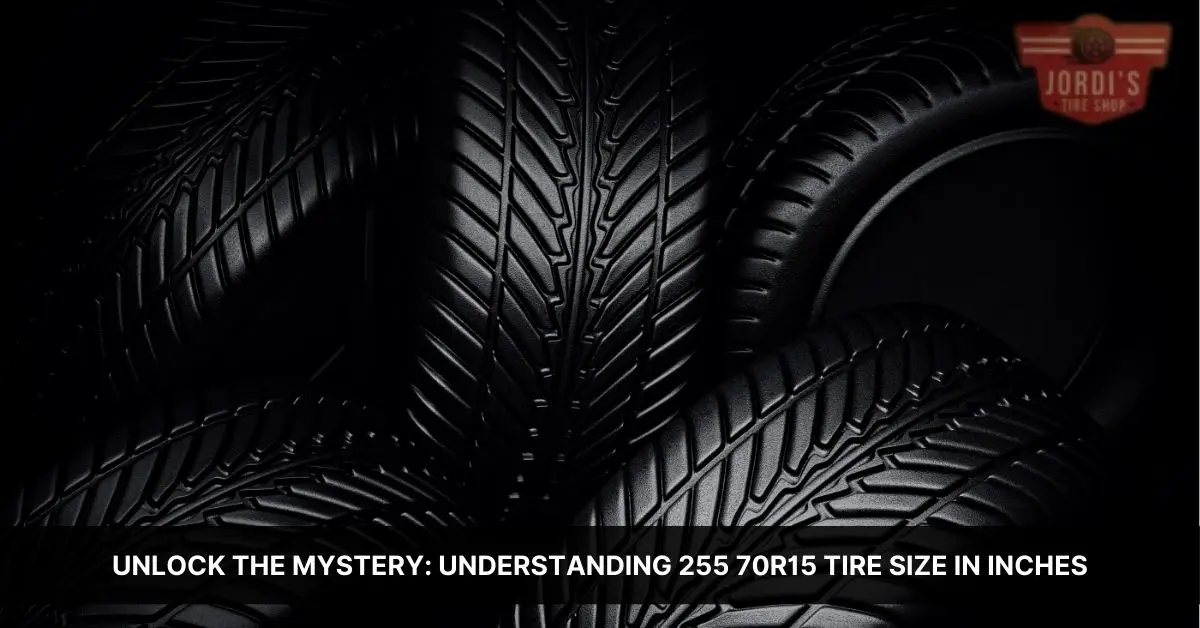Ever wondered what the cryptic numbers on your car’s tire mean? You’re not alone. One such number, 255 70r15, might seem like a secret code, but it’s just a standard way of describing tire size. Understanding it can help you make informed decisions about your vehicle’s tires.
Overview of 255 70r15 Tire Size

Diving deeper into the industry of tires, we navigate the concept of tire size. This section provides a detailed breakdown of the 255 70r15 tire size and what each number and letter represents.
Understanding Tire Size Notation
In the tire size formula, each digit and letter holds its unique significance. The first number “255” tells you the tire’s width in millimeters, the two-digit number “70” after the first represents the aspect ratio, and “r” stands for radial, signifying the tire’s construction typology. Finally, the “15” refers to the wheel’s diameter in inches that the tire is designed to fit.
For example, in the case of a 255 70r15 tire size:
- “255” indicates the tire’s cross-sectional width, that’s 255 millimeters from sidewall edge to sidewall edge.
- “70” determines the height of the tire’s profile from the rim to the tread as a percentage of the width. Here, it’s calculated as 70% of 255 millimeters.
- “r” elucidates to the reader that it’s of radial construction.
- “15” confirms the wheel diameter, capable of affixing to a 15-inch rim.
Insights on the “255 70r15” Notation
The notation 255 70r15 depicts a tire relatively wide and tall, suitable for trucks or SUVs aiming for off-road performance, comfort, and durability. It’s specifically designed to mount on a 15-inch rim, fairly common among vehicles of this type. Anything smaller or larger could potentially affect the vehicle’s performance and stability, potentially making it dangerous.
To further exemplify, let’s consider two scenarios:
- A smaller width number would mean a narrower tire, reducing grip but potentially improving fuel efficiency.
- A larger aspect ratio would result in a higher-profile tire, improving comfort but possibly impairing handling.
As the saying goes, knowledge is power – the more informed you are about tire size notations, the better decisions you can make about tire purchases for your vehicles. Make sure to match your driving needs with the appropriate tire size.
Converting 255 70r15 to Inches

Understanding tire sizes can be a challenge, but with a little calculation, it’s possible to convert these confusing numbers into something more understandable!
Explanation of the Conversion Process
First, let’s look at how to convert the tire width and aspect ratio, represented by ‘255’ and ’70’ respectively, from millimeters to inches. To convert ‘255’, the tire width, to inches, you’d divide it by 25.4, the number of millimeters in an inch. The result reveals that the tire is approximately 10 inches wide. When it comes to the aspect ratio ’70’, this percentage refers to the height of the tire from bead to top. It’s calculated as a percentage of the width, making it 70% of 10 inches, approximately 7 inches.
Don’t forget about the ‘r’ and ’15’ in ‘255 70r15’. The ‘r’ indicates radial construction, which refers to how the internal parts of the tire are arranged. The ’15’, on the other hand, already signifies the wheel diameter in inches. There’s no need for conversion—it’s already in inches!
Comparing 255 70r15 with Other Common Tire Sizes
Now that you grasp the ins and outs of 255 70r15 tires, it’s insightful to juxtapose this tire size with others. This comparison can offer you a holistic understanding of available options, boosting your capacity to make advantageous tire choices customized to your driving needs.
Comparison with Other “70” Series Tires
In the area of “70” series tires, the 255 70r15 size is not alone. Tire sizes like 235 70r15 and 265 70r15 constitute notable alternatives. Although all fall within the “70” series, there are important distinctions. For instance, the ‘235’ in 235 70r15 indicates a smaller width – approximately 9.25 inches compared to 255 70r15’s 10 inches. On the other hand, the ‘265’ in 265 70r15 denotes a wider tire, approximately 10.43 inches wide. Depending on your automotive configuration and driving conditions, these variances could bear impact on handling, traction, fuel efficiency, or comfort.
So, it’s instrumental to consider how these differences might play out in practical scenarios. For instance, a narrower 235 70r15 tire might offer increased fuel efficiency but compromised off-road performance. In contrast, a wider 265 70r15 tire might amplify off-road prowess but potentially decelerate responsiveness on turns.
Comparison with Different Aspect Ratio Tires
Beyond the 70 series, a universe of other aspect ratio tires awaits. Honorably mentioning such as 255 65r15 or 255 75r15 – they carry the same width (approximately 10 inches) but differ in aspect ratios, thereby influencing the overall tire height and performance attributes.
For example, a 255 65r15 tire, with its lower aspect ratio at ’65’, will have a shorter sidewall – roughly 6.5 inches. That’s shorter than our original 255 70r15 tire, which has a sidewall height of about 7 inches. Now, this might enhance handling and cornering abilities but possibly skew the ride comfort. On the opposite end, a 255 75r15 tire, with a ’75’ aspect ratio, will have a taller sidewall – approximately 7.5 inches. This could augment off-road performance and ride comfort, but perhaps at the expense of handling.
Hence, when exploring different aspect ratio tires, it’s essential to predicate your choice on your driving preferences, factoring in variables such as comfort, handling, fuel efficiency, road conditions, among others.
Impact of 255 70r15 Size on Vehicle Performance

Understanding how the 255 70r15 tire size affects vehicle performance can empower your choice of tires, tailoring it to your exact needs. This knowledge is essential as the tire size plays a important role in factors such as vehicle handling and fuel efficiency.
Effect on Vehicle Handling and Stability
Opting for 255 70r15 tires can significantly impact your vehicle’s handling and stability. These tires, with their wider width of around 10 inches and larger aspect ratio resulting in a height of about 7 inches, provide a larger contact patch. The larger the contact patch, the greater the grip, improving stability and handling. Particularly for vehicles like trucks and SUVs, their off-road capabilities benefit greatly from the improved grip these tires provide.
But remember, size isn’t the only factor affecting handling and stability. Factors such as tire tread, compound, and inflation pressure play important roles, too. Always keeping these in mind when selecting tires ensures you get ones that truly match your needs.
Effect on Fuel Efficiency
The choice of 255 70r15 tire size might impact your vehicle’s fuel efficiency, too. You might wonder how tire size influences fuel economy. Here’s the explanation: wider and larger tires often mean more rolling resistance due to a more massive contact patch. This resistance implies your vehicle’s engine needs to work harder to keep the car moving, resulting in higher fuel consumption.
In contrast, narrower tires with smaller aspect ratios typically offer less rolling resistance and, hence, greater fuel efficiency. But, this doesn’t mean that you should always go for the narrowest tires. It is crucial to reach a compromise between fuel efficiency, handling, and riding comfort, taking your driving conditions and preferences into account.
Selecting the right tire size isn’t a one-size-fits-all solution. It’s essential to find the perfect balance that suits your vehicle type, driving style, and conditions. Armed with the necessary knowledge, you can make informed decisions and enjoy a superior driving experience.
Tips for Buying 255 70r15 Tires

Taking everything into account, selecting the right 255 70r15 tire should not be an arbitrary decision. Rather, it’s a calculated move, considering factors appropriately aligned to your driving habits, your vehicle requirements, and your budget constraints. Our exploration of the factors to consider and recommendations for high-performing tire brands will help you become a savvy shopper.
Things to Consider Before Buying
Familiarize yourself with certain pivots before purchasing a 255 70r15 tire. Firstly, ascertain your vehicle’s requirements, taking into account the manufacturer’s specifications about the right tire size and load capacity. Secondly, consider your driving style and routine. For instance, if you frequently tread on rough terrains or steep slopes, prioritize tires with robust traction and stability. Finally, review your budget, ensuring you strike a balance between affordability and durability. Remember, you’re not obliged to spend exorbitantly. There are high-performing budget-friendly tires available in the market.
Recommended 255 70r15 Tire Brands
There’s no scarcity of tire brands offering 255 70r15 sizes. But, unstinting reliability and superior performance come from brands with a proven track record and positive customer reviews. Among such brands, BFGoodrich stands tall with its All-Terrain T/A KO2, gaining popularity for its excellent traction and off-road capabilities. Another brand, Michelin, with its Defender LTX M/S, prides in offering longevity and enhanced fuel efficiency. Finally, Bridgestone’s Dueler H/L Alenza is also worth considering for its blend of comfort, durability, and year-round performance. Bear in mind, but, the perfect tire is not a universal concept but a personal decision based on exact needs.
Conclusion
You’ve now got a firm grip on the 255 70r15 tire size. With this knowledge, you’re better equipped to choose tires that match your vehicle’s needs and your driving style. You understand the width, aspect ratio, and wheel diameter of these tires, and how these dimensions impact handling, fuel efficiency, and comfort. You’ve also learned how to convert these measurements from millimeters to inches, making tire comparisons a breeze.
Remember, wider tires like the 255 70r15 provide better traction and stability, but they might also increase fuel consumption. So, it’s all about finding the right balance for your exact needs. And when it comes to buying your tires, don’t forget to consider your vehicle’s specifications, your driving habits, and your budget. Brands like BFGoodrich, Michelin, and Bridgestone offer some great options. Armed with this knowledge, you’re ready to make an well-informed choice and enhance your driving experience.
Frequently Asked Questions
What does 255 70r15 mean?
The numbers on the tire, 255 70r15, represent its size specifications. “255” signifies the tire’s width in millimeters, “70” outlines the aspect ratio (70% of the width), “r” indicates radial construction, and “15” refers to the wheel’s diameter in inches. It is a tire size compatible with trucks or SUVs emphasizing comfort, off-road performance, and durability.
How do you convert tire size from millimeters to inches?
To convert tire size from millimeters to inches, divide the width and aspect ratio by 25.4. For instance, a width of ‘255’ results in approximately 10 inches, and an aspect ratio of ’70’ equates to a height of around 7 inches.
How does the 255 70r15 tire size impact car performance?
The 255 70r15 tire size, being relatively wider and taller, can improve the car’s grip and stability, especially for trucks and SUVs. However, wider tires could lead to higher fuel consumption due to increased rolling resistance. Optimal performance also depends on factors like tire tread, compound, and inflation pressure.
How does one choose the right 255 70r15 tire?
Selecting the right tire involves considering your vehicle’s specifications, your driving habits, and your budget. Reliable tire brands like BFGoodrich, Michelin, and Bridgestone offer high-quality 255 70r15 tires known for good traction, durability, and performance. However, your ideal tire choice is personal and should align with your specific needs.
Related Posts:
- Unlock the Code: Converting 215 70R15 Tire Size to Inches for Enhanced Vehicle PerformanceDemystifying Tire Sizes: Your Ultimate Guide to Understanding 225 75r15 in InchesUnlock the Mystery: Understanding 255 70r15 Tire Size in Inches
- Demystifying Tire Sizes: A Detailed Overview of 215 75r15 in Inches
- Decoding the Mystery: Converting 295 50r15 Tire Size into Inches
- Decoding Tire Sizes: Understanding the 225 70r15 measurements in Inches
- Deciphering Tire Size: Understanding & Converting 255 60r15 Dimensions to Inches
- Unraveling the Secrets of Tire Sizes: A Comprehensive Guide to 265 70r15 in Inches







